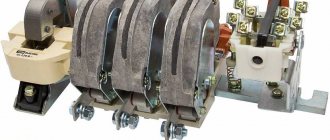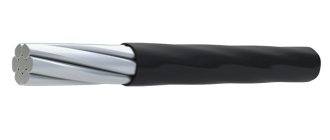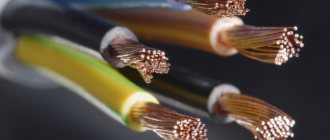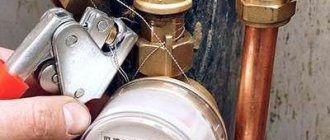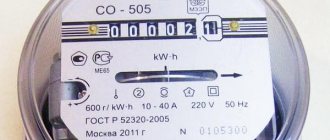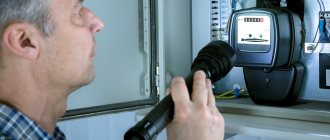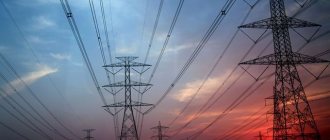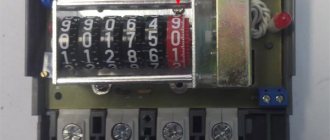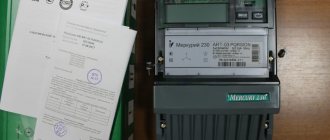1.5.21
For 110 and 220 kV bypass switches with built-in current transformers, it is allowed to reduce the accuracy class of these current transformers by one step relative to that specified in 1.5.16.
For a 110 kV bypass switch and a 110 kV bus-connection (intersection) switch used as a bypass switch, with separate current transformers (having no more than three secondary windings), it is allowed to switch on the meter current circuits together with the protection circuits when using intermediate current transformers of an accuracy class of no more than 0.5; in this case, it is allowed to reduce the accuracy class of current transformers by one step.
The same inclusion of meters and reduction of the accuracy class of current transformers is allowed for a bus-connection (intersection) switch for a voltage of 220 kV, used as a bypass switch, with free-standing current transformers, and for a voltage of 110-220 kV with built-in current transformers.
GENERAL REQUIREMENTS
1.5.4. Accounting for active electricity should provide determination of the amount of energy:
1) generated by power plant generators;
2) consumed for own and economic (separately) needs of power plants and substations;
3) supplied to consumers via lines extending from the power plant buses directly to consumers;
4) transferred to other energy systems or received from them;
5) released to consumers from the electrical network.
In addition, active electricity metering should provide the ability to:
determining the flow of electricity into electrical networks of different voltage classes of the power system;
compiling electricity balances for self-supporting units of the energy system;
monitoring compliance by consumers with their prescribed consumption regimes and electricity balance.
1.5.5. Accounting for reactive electricity should provide the ability to determine the amount of reactive electricity received by the consumer from the power supply organization or transferred to it only if these data are used to make calculations or monitor compliance with the specified operating mode of compensating devices.
2.5.238
When crossing an overhead line with an underground communication cable and a power supply (or with an underground cable insert), the following requirements must be met:
1) the angle of intersection of overhead lines up to 500 kV with LS and LPV is not standardized, the angle of intersection of 750 kV overhead lines with LS and LPV should be as close as possible to 90°, but not less than 45°;
2) the distance from underground cables LS and LPV to the nearest ground electrode of an overhead line support with voltage up to 35 kV or its underground metal or reinforced concrete part must be at least:
in populated areas - 3 m;
in uninhabited areas - the distances given in Table 2.5.26.
Table 2.5.26 Shortest distances from underground cables LS (LPV) to the nearest ground electrode of the overhead line support and its underground part
| Equivalent earth resistivity, Ohm m | Shortest distance, m, at overhead line voltage, kV | ||
| Up to 35 | 110-500 | 750 | |
| Up to 100 | 10 | 10 | 15 |
| More than 100 to 500 | 15 | 25 | 25 |
| More than 500 to 1000 | 20 | 35 | 40 |
| More than 1000 | 30 | 50 | 50 |
The distance from underground LAN and LPV cables to the underground part of an ungrounded wooden support of an overhead line with voltage up to 35 kV must be at least:
in populated areas - 2 m; in cramped conditions, the specified distance can be reduced to 1 m, provided that the cable is laid in a polyethylene pipe at a length on both sides of the support of at least 3 m;
in uninhabited areas: 5 m - with an equivalent earth resistivity of up to 100 Ohm m; 10 m - with an equivalent earth resistivity from 100 to 500 Ohm m; 15 m - with an equivalent earth resistivity from 500 to 1000 Ohm m; 25 m - with an equivalent earth resistivity of more than 1000 Ohm m;
3) the distance from the underground cables of LAN and LPV to the nearest ground electrode of the overhead line support of 110 kV and above and its underground part must be no less than the values given in Table 2.5.26;
4) when laying an underground cable (cable insert) in steel pipes, or when covering it with a channel, an angle, or when laying it in a polyethylene pipe, closed on both sides from the ingress of earth, at a length equal to the distance between the overhead line wires plus 10 m with on each side from the outermost wires for overhead lines up to 500 kV and 15 m for overhead lines 750 kV, it is allowed to reduce the distances indicated in Table 2.5.26 to 5 m for overhead lines up to 500 kV and up to 10 m for 750 kV.
In this case, the metal covers of the cable should be connected to a pipe or other metal protective elements. This requirement does not apply to optical cables and cables with an external insulating hose, including those with a metal sheath. The metal covers of the cable insert must be grounded at the ends. When reducing the distances between the cable and the overhead line supports specified in Table 2.5.26, in addition to the given protection measures, it is necessary to install additional protection against lightning strikes by lining the supports with cables in accordance with the requirements of regulatory documentation for the protection of cables from lightning strikes;
5) instead of using a channel, angle or steel pipe, when constructing a new overhead line, it is allowed to use two steel cables with a cross-section of 70 mm, laid symmetrically at a distance of no more than 0.5 m from the cable and at a depth of 0.4 m. The cables must be extended on both sides at an angle of 45° to the route towards the overhead line support and grounded to a resistance of no more than 30 Ohms. The relationship between the length of the cable outlet and the grounding resistance must correspond to the values and given in Table 2.5.27;
Table 2.5.27 Resistance of grounding conductors when protecting LAN and LPV cables at the intersection with overhead lines
INSTALLATION POINTS FOR ELECTRICITY METERING MEANS
1.5.6. It is recommended to install meters for calculating the electricity supply organization with electricity consumers at the boundary between the network (according to balance sheet ownership) of the electricity supply organization and the consumer.
1.5.7. Estimated active electricity meters at the power plant must be installed:
1) for each generator in such a way that all the electricity generated by the generator is taken into account;
2) for all connections of generator voltage buses for which reverse operation is possible - two meters with stoppers;
3) for intersystem power lines - two meters with stoppers that take into account the supplied and received electricity;
4) for lines of all voltage classes coming from power plant buses and belonging to consumers (see also 1.5.10).
For lines up to 10 kV extending from power plant buses, in all cases metering circuits, terminal assemblies must be installed (see 1.5.23), and places for installing meters must be provided;
5) for all transformers and lines supplying main voltage buses (above 1 kV) for auxiliary needs (MV).
The meters are installed on the high voltage side; if the MV transformers of the power plant are powered from busbars of 35 kV and higher or by branching from units at voltages above 10 kV, it is allowed to install meters on the low voltage side of the transformers;
6) for lines of economic needs (for example, power supply to mechanisms and installations of repair and production bases) and external consumers connected to the MV switchgear of power plants;
7) for each bypass switch or for a bus connecting (inter-section) switch used as a bypass for connections that have metering, two meters with stoppers.
At power plants equipped with systems for centralized collection and processing of information, these systems should be used for centralized calculation and technical accounting of electricity. At other power plants, it is recommended to use an automated electricity metering system.
1.5.8. At power plants with a capacity of up to 1 MW, rated active electricity meters should be installed only for generators and MV transformers or only for MV transformers and outgoing lines.
1.5.9. Calculated active electricity meters at power system substations must be installed:
1) for each outgoing power line owned by consumers (see also 1.5.10);
2) for intersystem power lines - two meters with stoppers, taking into account the supplied and received electricity; if there are branches from these lines to other power systems - two meters with stoppers, taking into account the received and supplied electricity, at the inputs to the substations of these power systems;
3) on MV transformers;
4) for lines for household needs or external consumers (villages, etc.) connected to the MV busbars.
5) for each bypass switch or for a bus connecting (intersection) switch used as a bypass for connections that have metering, two meters with stoppers.
For lines up to 10 kV, in all cases, metering circuits, terminal assemblies must be made (see 1.5.23), and places for installing meters must be provided.
1.5.10. Calculation meters provided in accordance with 1.5.7, clause 4 and 1.5.9, clause 1, may be installed not at the supply end, but at the receiving end of the line at the consumer in cases where the current transformers at power plants and substations are selected by current Short circuits or busbar differential protection characteristics do not provide the required accuracy of electricity metering.
1.5.11. Calculated active electricity meters at a substation owned by a consumer must be installed:
1) at the input (receiving end) of the power line to the consumer substation in accordance with 1.5.10 in the absence of electrical connection with another power system substation or another consumer at the supply voltage;
2) on the higher voltage side of the transformers of the consumer substation if there is an electrical connection with another substation of the power system or there is another consumer at the supply voltage.
It is allowed to install meters on the low voltage side of transformers in cases where current transformers, selected by short-circuit current or by the characteristics of differential protection of buses, do not provide the required accuracy of electricity metering, and also when the existing built-in current transformers do not have a winding of accuracy class 0.5.
In cases where the installation of additional sets of current transformers on the low voltage side of power transformers to switch on metering meters is impossible (switchgear switchgear, switchgear switchgear), it is allowed to organize metering on outgoing lines of 6 - 10 kV.
For an enterprise that pays an electricity supplying organization for the maximum declared power, it should be necessary to install a meter with a maximum load indicator if there is one metering point; if there are two or more metering points, the use of an automated electricity metering system;
3) on the medium and low voltage side of power transformers, if on the high voltage side the use of instrument transformers is not required for other purposes;
4) on MV transformers, if the electricity supplied for own needs is not taken into account by other meters; in this case, it is recommended to install meters on the low voltage side;
5) at the interface between the main consumer and an external consumer (sub-subscriber), if another external consumer, who is on an independent balance, is powered from the line or consumer transformers.
Separate billing meters should be installed for consumers of each tariff group.
1.5.12. Reactive electricity meters must be installed:
1) on the same circuit elements on which active electricity meters are installed for consumers paying for electricity taking into account the reactive power allowed for use;
2) at connections of consumer reactive power sources, if they are used to pay for electricity supplied to the power system network, or control the specified operating mode.
If the enterprise, with the consent of the power system, supplies reactive electricity to the power system network, it is necessary to install two reactive electricity meters with stoppers in those circuit elements where the calculated active electricity meter is installed. In all other cases, one reactive electricity meter with a stopper must be installed.
For an enterprise that pays the energy supplying organization for the maximum permitted reactive power, it is necessary to install a meter with a maximum load indicator; if there are two or more metering points, the use of an automated electricity metering system.
7.1.38
Electrical networks laid behind impenetrable suspended ceilings and in partitions are considered as hidden electrical wiring and should be installed: behind ceilings and in the voids of partitions made of flammable materials in metal pipes with localization capabilities and in closed boxes; behind ceilings and in partitions made of non-combustible materials* - in pipes and ducts made of non-flammable materials, as well as flame retardant cables. In this case, it must be possible to replace wires and cables.
_______________
* Suspended ceilings made of non-combustible materials mean those ceilings that are made of non-combustible materials, while other building structures located above suspended ceilings, including interfloor ceilings, are also made of non-combustible materials.
General requirements. Electricity supply
7.1.13. Electrical receivers must be powered from a 380/220 V network with a TN-S or TN-CS grounding system.
When reconstructing residential and public buildings with a network voltage of 220/127 V or 3 x 220 V, the network should be switched to a voltage of 380/220 V with a TN-S or TN-CS grounding system.
7.1.14. External power supply to buildings must meet the requirements of Chapter 1.2.
7.1.15. In dormitories of various institutions, in schools and other educational institutions, etc. the construction of built-in and attached substations is not allowed.
In residential buildings, in exceptional cases, it is allowed to place built-in and attached substations using dry-type transformers in agreement with state supervisory authorities, while sanitary requirements for limiting noise and vibration levels must be fully met in accordance with current standards.
The construction and placement of built-in, attached and free-standing substations must be carried out in accordance with the requirements of the chapters of Section. 4.
7.1.16. It is recommended that power and lighting electrical receivers be powered from the same transformers.
7.1.17. The location and layout of transformer substations must provide for the possibility of round-the-clock unhindered access to them for personnel of the energy supply organization.
7.1.18. Power supply for safety lighting and evacuation lighting must be carried out in accordance with the requirements of Chapter. 6.1 and 6.2, as well as SNiP 23-05-95 “Natural and artificial lighting”.
7.1.19. If there are elevators in the building, which are also intended for transporting fire departments, their power supply must be provided in accordance with the requirements of Chapter. 7.4.
7.1.20. Electrical networks of buildings must be designed to power advertising lighting, shop windows, facades, illumination, outdoor, fire-fighting devices, dispatch systems, local television networks, light indicators of fire hydrants, safety signs, bell and other alarms, light fencing lights, etc., in in accordance with the design specifications.
7.1.21. When supplying single-phase consumers of buildings from a multiphase distribution network, it is allowed for different groups of single-phase consumers to have common N and PE conductors (five-wire network) laid directly from the ASU; combining N and PE conductors (four-wire network with PEN conductor) is not allowed.
When supplying single-phase consumers from a multiphase supply network with branches from overhead lines, when the PEN conductor of the overhead line is common to groups of single-phase consumers powered from different phases, it is recommended to provide protective shutdown of consumers when the voltage exceeds the permissible limit, arising due to load asymmetry when the PEN breaks conductor. The disconnection must be carried out at the entrance to the building, for example, by influencing the independent release of the input circuit breaker using a maximum voltage relay, and both the phase (L) and neutral working (N) conductors must be disconnected.
When choosing devices and devices installed at the input, preference, other things being equal, should be given to devices and devices that remain operational when the voltage exceeds the permissible voltage, arising due to load asymmetry when the PEN or N conductor breaks, while their switching and other performance specifications may not be met.
In all cases, it is prohibited to have switching contact and non-contact elements in PE and PEN conductor circuits.
Connections that can be disassembled with a tool are allowed, as well as connectors specially designed for this purpose.
SCOPE, DEFINITIONS
1.5.1. This chapter of the Rules contains requirements for electricity metering in electrical installations. Additional requirements for electricity metering in residential and public buildings are given in Chapter. 7.1.
1.5.2. Estimated metering of electricity is the accounting of electricity generated and also supplied to consumers in order to pay for it in cash.
Meters installed for settlement accounting are called settlement meters.
1.5.3. Technical (control) metering of electricity is metering for monitoring electricity consumption inside power plants, substations, enterprises, buildings, apartments, etc.
Meters installed for technical metering are called technical metering meters.
7.1.48
Installation of plug sockets in bathrooms, showers, soap rooms of baths, rooms containing heaters for saunas (hereinafter referred to as “saunas”), as well as in washing rooms of laundries is not allowed, with the exception of bathrooms in apartments and hotel rooms.
In the bathrooms of apartments and hotel rooms, it is allowed to install plug sockets in zone 3 in accordance with GOST R 50571.11-96, connected to the network through isolation transformers or protected by a residual current device that responds to a differential current not exceeding 30 mA.
Any switches and sockets must be located at a distance of at least 0.6 m from the doorway of the shower stall.
Construction company LLC “Artpaint”. Construction of engineering networks and communications
Crossing underground networks
In a modern city, intersections of underground networks are inevitable. The location of pipelines and cables at these intersections is determined by design, operational and sanitary requirements.
Structural requirements include the independence of settlement of different networks at the intersection under the influence of permanent and temporary loads. Based on this, one pipeline should not be allowed to directly rest on another, as this could result in fractures of the upper or lower pipeline.
To ensure independent settlement, the distance between the outer walls of the pipes should be about 15 cm.
According to operational and technical conditions, there must also be a certain distance between individual vertical communications, sufficient for the repair of individual networks.
In all cases of intersection of water pipes with gas pipelines and heat pipes, the vertical distance between them must be at least 0.15 m and in exceptional cases - 0.10 m. Water pipes can be passed through channels in which heat pipes are located.
It is recommended to lay water pipes at the intersection with sewer pipes higher than the latter, but in practice this is not always possible. Sewer pipes laid above water pipes at a length of 3-4 m must be metal (preferably cast iron) at the intersection.
If a medium-diameter sewerage system, consisting of ceramic or link concrete pipes, is laid above the water supply system, then at the intersection site the sewerage pipes should be embedded in concrete masses.
When crossing gas pipelines, heating pipelines or water pipelines at the same level with gravity sewers and drains on metal pressure pipelines, it is necessary to arrange contours near the gravity lines.
If a gas pipeline crosses a sewer or drainage collector, then in exceptional cases it is allowed to pass the gas pipeline through the collector. In this case, it is necessary to enclose the gas pipeline in a steel casing, the ends of which must be brought out at least 0.5 m from the outer surface of the collector walls, and there should be no pipe joints within the casing.
When drainage and sewer pipes intersect at the same level, a difference may be created on one of them, depending on local conditions. But in some cases, the differential device is inconvenient and uneconomical, especially on collectors. Therefore, a sewer pipe, as a permanent one, can be laid in the form of a siphon under a drain in compliance with all design requirements for siphons.
Underground networks when crossing tram tracks should be located at a depth of at least 1 m from the base of the rail to the top of the pipe or cable casing and laid at right angles or at least 75° to the track axes.
Typically, the normal depth of laying metal pipelines in order to reduce the influence of stray electric currents should be at least 1.5-2 m. In this case, the pipelines must have reliable coatings and be laid in a wooden or asbestos-cement case with bitumen filling the gap between the pipe and the case with a thickness of 25-20 m. 50 mm. The case must have a length of at least 2 liters from the outermost threads of the rail tracks.
When crossing power cables (as well as power cables with communication cables) laid directly into the ground, the distance between them must be at least 0.5 m. Communication cables should be located above the power cables. The required distance between pipelines and cables is 0.5 m. If for some reason this distance needs to be reduced, then the pipelines are separated from the cables by fire-resistant plates or the cables are enclosed in pipes. In this case, the vertical distance between communications is allowed to be at least 250 mm.
If there are a number of pipelines, cables and channels at street intersections, it is advisable to arrange underground chambers in which the intersection of all pipelines and control of the fittings installed on them are concentrated.
The design of these cameras is similar to cameras on combined collectors.
INSTALLATION OF METERS AND ELECTRICAL WIRING TO THEM
1.5.27. Meters must be located in dry rooms that are easily accessible for maintenance, in a place that is sufficiently free and not cramped for work, with a temperature in winter not lower than 0 degrees. C.
General industrial meters are not allowed to be installed in rooms where, due to production conditions, the temperature can often exceed +40 degrees. C, as well as in rooms with aggressive environments.
It is allowed to place meters in unheated rooms and corridors of switchgears of power plants and substations, as well as in outdoor cabinets. In this case, provision should be made for their stationary insulation for the winter through insulating cabinets, hoods with heating of the air inside them with an electric lamp or heating element to ensure a positive temperature inside the hood, but not higher than +20 degrees. C.
1.5.28. Meters designed to account for electricity generated by power plant generators should be installed in rooms with an average ambient temperature of +15 - +25 degrees. C. In the absence of such premises, it is recommended that meters be placed in special cabinets, where the specified temperature must be maintained throughout the year.
1.5.29. Meters must be installed in cabinets, chambers of complete switchgears (KRU, KRUN), on panels, switchboards, in niches, on walls with a rigid structure.
It is allowed to mount meters on wooden, plastic or metal panels.
The height from the floor to the meter terminal box must be within 0.8 - 1.7 m. A height of less than 0.8 m is allowed, but not less than 0.4 m.
1.5.30. In places where there is a danger of mechanical damage to meters or their contamination, or in places accessible to unauthorized persons (passages, staircases, etc.), a locked cabinet with a window at dial level should be provided for meters. Similar cabinets should also be installed to co-locate meters and current transformers when performing metering on the low voltage side (at the consumer input).
1.5.31. Designs and sizes of cabinets, niches, panels, etc. should provide convenient access to the terminals of meters and current transformers. In addition, it must be possible to conveniently replace the meter and install it with a slope of no more than 1 degree. The design of its fastening must ensure the possibility of installing and removing the meter from the front side.
1.5.32. Electrical wiring to meters must meet the requirements given in Chapter. 2.1 and 3.4.
1.5.33. The presence of rations in the electrical wiring to the settlement meters is not allowed.
1.5.34. The cross-sections of wires and cables connected to meters must be taken in accordance with 3.4.4 (see also 1.5.19).
1.5.35. When installing electrical wiring to connect direct-connection meters, it is necessary to leave the ends of the wires with a length of at least 120 mm near the meters. The insulation or sheath of the neutral wire at a length of 100 mm in front of the meter must have a distinctive color.
1.5.36. For safe installation and replacement of meters in networks with voltages up to 380 V, it must be possible to turn off the meter by switching devices or fuses installed before it at a distance of no more than 10 m. Voltage relief must be provided from all phases connected to the meter.
Current transformers used to connect meters for voltages up to 380 V must be installed after switching devices in the direction of power flow.
1.5.37. Grounding (grounding) of meters and current transformers must be carried out in accordance with the requirements of Chapter. 1.7. In this case, the grounding and neutral protective conductors from meters and current transformers with voltages up to 1 kV to the nearest terminal assembly must be copper.
1.5.38. If there are several connections at the facility with separate electricity metering, the meter panels must contain inscriptions with the names of the connections.
2.1.49
For stationary electrical wiring, predominantly wires and cables with aluminum conductors should be used. For exceptions, see 2.1.70, 3.4.3, 3.4.12, 5.5.6, 6.5.12-6.5.14, 7.2.53 and 7.3.93.
Table 2.1.2. Selecting types of electrical wiring, installation methods and wires and cables
| Conditions environment | Type of electrical wiring and installation method | Wires and cables |
| Open wiring | ||
| Dry and wet areas | On roller skates and skating | Unprotected solid wires |
| Dry rooms | Same | Twisted two-core wires |
| Premises of all types and outdoor installations | On insulators, as well as on rollers intended for use in damp places. In outdoor installations, rollers for damp places (large sizes) may only be used in places where there is no possibility of direct rain or snow coming into contact with the electrical wiring (under canopies) | Unprotected solid wires |
| Outdoor installations | Directly on the surface of walls, ceilings and on strings, strips and other supporting structures | Non-metallic and metallic sheathed cable |
| Premises of all types | Same | Unprotected and protected single and multi-core wires. Cables with non-metallic and metallic sheaths |
| Premises of all types and outdoor installations | On trays and in boxes with openable lids | Same |
| All types of premises and outdoor installations (only special wires with a supporting cable for outdoor installations or cables) | On ropes | Special wires with a supporting cable. Unprotected and protected single and multi-core wires. Cables with non-metallic and metallic sheaths |
| Hidden electrical wiring | ||
| Premises of all types and outdoor installations | In non-metallic pipes made of combustible materials (non-self-extinguishing polyethylene, etc.). In closed channels of building structures. Under the plaster | Unprotected and protected, single and multi-core wires. Non-metallic sheathed cables |
| Exceptions: | ||
| 1. The use of insulating pipes with a metal sheath in damp, especially damp rooms and outdoor installations is prohibited. | ||
| 2. It is prohibited to use steel pipes and steel blind boxes with a wall thickness of 2 mm or less in damp, especially damp rooms and outdoor installations. | ||
| Dry, wet and damp areas | Embedded in building structures during their manufacture | Unprotected wires |
| Open and hidden electrical wiring | ||
| Premises of all types and outdoor installations | In metal flexible sleeves. In steel pipes (ordinary and thin-walled) and blind steel boxes. In non-metallic pipes and non-metallic blind boxes made of fire-resistant materials. In insulating pipes with metal sheath | Unprotected and protected single and multi-core wires. Non-metallic sheathed cables |
| Exceptions: | ||
| 1. The use of insulating pipes with a metal sheath in damp, especially damp rooms and outdoor installations is prohibited. | ||
| 2. It is prohibited to use steel pipes and steel blind boxes with a wall thickness of 2 mm or less in damp, especially damp rooms and outdoor installations. |
Table 2.1.3. Selecting types of electrical wiring and methods of laying wires and cables according to fire safety conditions
Now about grounding, grounding conductor and grounding conductor of a private house
Re-grounding of the neutral conductor when air powering the house can be done on a support pole or near the house.
Grounding on an overhead power line support
When installing an input device on a concrete support from which the power supply to the house branches off, it is quite justified and recommended to re-ground it using natural grounding conductors. As a natural grounding conductor, you can use the underground part of the support itself or its lightning protection circuit (clause 1.7.109-110, PUE).
Important! Re-grounding on a reinforced concrete pole is possible only if the overhead power line is made of insulated, self-supporting SIP type wires. Since they are mechanically stronger than wires without insulation
But still, if you want a more reliable, safe and independent grounding device for your home, it is better to make it using artificial grounding conductors.
Grounding a house with artificially made ground electrodes
House grounding is a grounding device, which consists of the following elements: a grounding conductor and a grounding conductor.
A grounding conductor is a conductor or several conductors connected to each other and having contact with the ground. A grounding conductor is connected to the grounding conductor, which is carefully brought out near the house and connected to the main grounding bus (GZSH). The cross-section of the grounding conductor must be no less than the cross-section of the PEN conductor.
Grounding electrodes can be made in different versions and be of different types.
- By type, grounding electrodes can be divided into: Vertical; Row; Ground loop.
- By type, grounding electrodes can be described as: Pin, Modular-pin, Loop and Foundation grounding electrodes.
The ground electrodes can be briefly described as follows:
The vertical grounding rod is a prefabricated copper or steel rod. The ground electrode is driven into the ground to a depth of 15-40 meters. In another way it is called a deep grounding electrode. The most modern type of home grounding. Does not require large excavations. (Details about deep grounding)
Row grounding. This is a prefabricated structure consisting of individual metal pins driven into the ground to a depth of 3-4 meters and connected by a metal strip. The distance between the pins must be at least 3 meters. The pins can be arranged in a row or in a triangle. Used only for secondary grounding. (Details on how to make in-line grounding)
The ground loop is made around the house in the form of a closed structure. The design of the ground loop also involves driving a pin into the ground. The pins are located along the perimeter of the foundation at a distance of 1 meter from it. The grounding pins are connected with a steel strip. Recommended for two lightning rods from the roofs and more than one power supply to the house. (Details about ground loops)
The foundation grounding system is made at the initial stage of building a house. The ground electrode is placed in the foundation of the house. Of all the ground electrodes, the foundation ground electrode is perhaps the most effective. (Details about foundation grounding)
Important! Whatever ground electrode you use in your home grounding device, the resistance to current spreading of the ground electrode should not exceed 10 Ohms for a linear voltage of 380 volts and 20 Ohms for a linear voltage of 220 volts with a three-phase power supply. And with a single-phase power supply, the resistance to current flow should not exceed 5 Ohms for 380 volts and 10 Ohms for a 220 volt power supply
(Details about measuring ground resistance)
And with a single-phase power supply, the resistance to current flow should not exceed 5 Ohms for 380 volts and 10 Ohms for a 220 volt power supply. (Details about measuring ground resistance)
Reading construction forums, I see that many do without secondary grounding in country houses. Grounding of the supply overhead line is considered sufficient. But still, you need to be guided not only by savings, but also by safety precautions for your family and property.
Elesant.ru
Normative references
- PUE, Electrical Installation Rules, edition 7
- GOST 121.030-81, Electrical safety. Protective grounding. Zeroing.
Other articles in the section: House electrical wiring
- 26 Rules for power supply and wiring of a wooden house. part 1, rules 1-7
- 26 Rules for power supply and wiring of a wooden house. part 2, rules 8-13
- 26 Rules for power supply and wiring of a wooden house. part 3, rules 14-26
- Anchor clamps and brackets
- Fittings for SIP 2
- Inserting cables from the trench into the house
- Input device. VU for a private house
- VRU. House input and distribution device
- GZSH. Main Grounding Bus
- Deep ground electrode
1.5.12
Reactive electricity meters must be installed:
1) on the same circuit elements on which active electricity meters are installed for consumers paying for electricity taking into account the reactive power allowed for use;
2) at connections of consumer reactive power sources, if they are used to pay for electricity supplied to the power system network, or control the specified operating mode.
If the enterprise, with the consent of the power system, supplies reactive electricity to the power system network, it is necessary to install two reactive electricity meters with stoppers in those circuit elements where the calculated active electricity meter is installed. In all other cases, one reactive electricity meter with a stopper must be installed.
For an enterprise that pays the energy supplying organization for the maximum permitted reactive power, it is necessary to install a meter with a maximum load indicator; if there are two or more metering points, the use of an automated electricity metering system.
PUE Chapter 1.5 Electricity metering
SCOPE, DEFINITIONS
1.5.1. This chapter of the Rules contains requirements for electricity metering in electrical installations. Additional requirements for electricity metering in residential and public buildings are given in Chapter. 7.1.
1.5.2. Estimated metering of electricity is the accounting of electricity generated and also supplied to consumers in order to pay for it in cash.
Meters installed for settlement accounting are called settlement meters.
1.5.3. Technical (control) metering of electricity is metering for monitoring electricity consumption inside power plants, substations, enterprises, buildings, apartments, etc.
Meters installed for technical metering are called technical metering meters.
GENERAL REQUIREMENTS
1.5.4. Accounting for active electricity should provide determination of the amount of energy:
1) generated by power plant generators;
2) consumed for own and economic (separately) needs of power plants and substations;
3) supplied to consumers via lines extending from the power plant buses directly to consumers;
4) transferred to other energy systems or received from them;
5) released to consumers from the electrical network.
In addition, active electricity metering should provide the ability to:
determining the flow of electricity into electrical networks of different voltage classes of the power system;
compiling electricity balances for self-supporting units of the energy system;
monitoring compliance by consumers with their prescribed consumption regimes and electricity balance.
1.5.5. Accounting for reactive electricity should provide the ability to determine the amount of reactive electricity received by the consumer from the power supply organization or transferred to it only if these data are used to make calculations or monitor compliance with the specified operating mode of compensating devices.
INSTALLATION POINTS FOR ELECTRICITY METERING MEANS
1.5.6. It is recommended to install meters for calculating the electricity supply organization with electricity consumers at the boundary between the network (according to balance sheet ownership) of the electricity supply organization and the consumer.
1.5.7. Estimated active electricity meters at the power plant must be installed:
1) for each generator in such a way that all the electricity generated by the generator is taken into account;
2) for all connections of generator voltage buses for which reverse operation is possible - two meters with stoppers;
3) for intersystem power lines - two meters with stoppers that take into account the supplied and received electricity;
4) for lines of all voltage classes coming from power plant buses and belonging to consumers (see also 1.5.10).
For lines up to 10 kV extending from the busbars of power plants, in all cases metering circuits, terminal assemblies must be installed (see 1.5.23 ), and places for installing meters must be provided;
5) for all transformers and lines supplying main voltage buses (above 1 kV) for auxiliary needs (MV).
The meters are installed on the high voltage side; if the MV transformers of the power plant are powered from busbars of 35 kV and higher or by branching from units at voltages above 10 kV, it is allowed to install meters on the low voltage side of the transformers;
6) for lines of economic needs (for example, power supply to mechanisms and installations of repair and production bases) and external consumers connected to the MV switchgear of power plants;
7) for each bypass switch or for a bus connecting (intersection) switch used as a bypass for connections that have metering - two meters with stoppers.
At power plants equipped with systems for centralized collection and processing of information, these systems should be used for centralized calculation and technical accounting of electricity. At other power plants, it is recommended to use an automated electricity metering system.
1.5.8. At power plants with a capacity of up to 1 MW, rated active electricity meters should be installed only for generators and MV transformers or only for MV transformers and outgoing lines.
1.5.9. Calculated active electricity meters at power system substations must be installed:
1) for each outgoing power line owned by consumers (see also 1.5.10);
2) for intersystem power transmission lines - two meters with stoppers, taking into account the supplied and received electricity; if there are branches from these lines to other power systems - two meters with stoppers, taking into account the received and supplied electricity, at the inputs to the substations of these power systems;
3) on MV transformers;
4) for lines for household needs or external consumers (villages, etc.) connected to MV buses;
5) for each bypass switch or for a bus connecting (intersection) switch used as a bypass for connections that have metering - two meters with stoppers.
For lines up to 10 kV, in all cases, metering circuits and terminal assemblies must be made (see 1.5.23 ), and places for installing meters must be provided.
1.5.10. Calculation meters provided in accordance with 1.5.7 , clause 4 and 1.5.9 , clause 1, are allowed to be installed not at the supply end, but at the receiving end of the line at the consumer in cases where the current transformers at power plants and substations are selected by current Short circuits or busbar differential protection characteristics do not provide the required accuracy of electricity metering.
1.5.11. Calculated active electricity meters at a substation owned by a consumer must be installed:
1) at the input (receiving end) of the power line to the consumer substation in accordance with 1.5.10 in the absence of electrical connection with another power system substation or another consumer at the supply voltage;
2) on the higher voltage side of the transformers of the consumer substation if there is an electrical connection with another substation of the power system or there is another consumer at the supply voltage.
It is allowed to install meters on the low voltage side of transformers in cases where current transformers, selected by short-circuit current or by the characteristics of differential protection of buses, do not provide the required accuracy of electricity metering, and also when the existing built-in current transformers do not have a winding of accuracy class 0.5.
In the case where the installation of kV.
For an enterprise that pays an electricity supplying organization at the maximum declared capacity, it should be necessary to install a meter with a maximum load indicator if there is one metering point; if there are two or more metering points, the use of an automated electricity metering system;
3) on the medium and low voltage side of power transformers, if on the high voltage side the use of instrument transformers is not required for other purposes;
4) on MV transformers, if the electricity supplied for own needs is not taken into account by other meters; in this case, it is recommended to install meters on the low voltage side;
5) at the interface between the main consumer and an external consumer (sub-subscriber), if another external consumer, who is on an independent balance, is powered from the line or consumer transformers.
Separate billing meters should be installed for consumers of each tariff group.
1.5.12. Reactive electricity meters must be installed:
1) on the same circuit elements on which active electricity meters are installed for consumers paying for electricity taking into account the reactive power allowed for use;
2) at connections of consumer reactive power sources, if they are used to pay for electricity supplied to the power system network, or control the specified operating mode.
If the enterprise, with the consent of the power system, supplies reactive electricity to the power system network, it is necessary to install two reactive electricity meters with stoppers in those circuit elements where the calculated active electricity meter is installed. In all other cases, one reactive electricity meter with a stopper must be installed.
For an enterprise that pays the energy supplying organization for the maximum permitted reactive power, it is necessary to install a meter with a maximum load indicator; if there are two or more metering points, the use of an automated electricity metering system.
REQUIREMENTS FOR CURRENT METERS
1.5.13. Each installed settlement meter must have seals with the state verifier's mark on the screws securing the meter casing, and on the clamping cover - a seal from the energy supply organization.
Newly installed three-phase meters must have state verification seals that are no more than 12 months old, and single-phase meters must have state verification seals that are no more than 2 years old.
1.5.14. Accounting for active and reactive electricity of three-phase current should be carried out using three-phase meters.
1.5.15. Acceptable accuracy classes of calculated active electricity meters for various metering objects are given below:
Generators with a capacity of more than 50 MW, intersystem
power lines 220 kV and above, transformers
with a capacity of 63 MB·A and more…………………………………………………………………………………. 0.5 (0.7)*
Generators with a capacity of 12 - 50 MW, intersystem lines
power transmission 110 - 150 kV, transformers with a capacity of 10 - 40 MB·A.... 1.0
Other accounting objects………………………………………………………………………………… 2.0
_____________
* The value indicated in brackets refers to imported counters.
The accuracy class of reactive electricity meters must be selected one step lower than the corresponding accuracy class of active electricity meters.
ACCOUNTING USING INSTRUMENTATION TRANSFORMERS
1.5.16. The accuracy class of current transformers and the voltage for connecting calculated electricity meters must be no more than 0.5. It is allowed to use voltage transformers of accuracy class 1.0 to switch on calculated meters of accuracy class 2.0.
To connect technical metering meters, it is allowed to use current transformers of accuracy class 1.0, as well as built-in current transformers of accuracy class below 1.0, if the installation of additional sets of current transformers is required to obtain accuracy class 1.0.
Voltage transformers used to connect technical metering meters may have an accuracy class below 1.0.
1.5.17. It is allowed to use current transformers with an increased transformation ratio (according to the conditions of electrodynamic and thermal resistance or busbar protection), if at the maximum load of the connection the current in the secondary winding of the current transformer is at least 40% of the rated current of the meter, and at a minimum operating load - at least 5 %.
1.5.18. The connection of the current windings of meters to the secondary windings of current transformers should, as a rule, be carried out separately from the protection circuits and together with electrical measuring instruments.
It is allowed to connect current circuits together if their separate connection requires the installation of additional current transformers, and the joint connection does not lead to a decrease in the accuracy and reliability class of the current transformer circuits used for metering and provides the necessary characteristics of relay protection devices.
The use of intermediate current transformers to switch on meter meters is prohibited (for an exception, see 1.5.21).
1.5.19. The load of the secondary windings of the instrument transformers to which the meters are connected should not exceed the rated values.
The cross-section and length of wires and cables in the voltage circuits of rated meters must be selected such that the voltage loss in these circuits is no more than 0.25% of the rated voltage when powered by voltage transformers of accuracy class 0.5 and no more than 0.5% when powered by voltage transformers of accuracy class 1.0. To ensure this requirement, it is allowed to use separate cables from voltage transformers to meters.
Voltage losses from voltage transformers to technical metering meters should be no more than 1.5% of the rated voltage.
1.5.20. To connect meter meters on power lines of 110 kV and above, it is allowed to install additional current transformers (in the absence of secondary windings for connecting meters, to ensure the meter operates in the required accuracy class, according to the load conditions on the secondary windings, etc.). See also 1.5.18.
1.5.21. For 110 and 220 kV bypass switches with built-in current transformers, it is allowed to reduce the accuracy class of these current transformers by one step relative to that specified in 1.5.16.
For a 110 kV bypass switch and a 110 kV bus-connection (intersection) switch used as a bypass switch, with separate current transformers (having no more than three secondary windings), it is allowed to switch on the meter current circuits together with the protection circuits when using intermediate current transformers of an accuracy class of no more than 0.5; in this case, it is allowed to reduce the accuracy class of current transformers by one step.
The same inclusion of meters and a reduction in the accuracy class of current transformers is allowed for a bus-connection (inter-section) switch for a voltage of 220 kV, used as a bypass switch, with free-standing current transformers, and for a voltage of 110 - 220 kV with built-in current transformers.
1.5.22. To power meter circuits, both single-phase and three-phase voltage transformers can be used, including four- and five-leg ones used for insulation monitoring.
1.5.23. Metering circuits should be routed to independent clamp assemblies or sections in a general row of clamps. If clamp assemblies are not available, test blocks must be installed.
The clamps must ensure short-circuiting of the secondary circuits of current transformers, disconnecting the meter's current circuits and voltage circuits in each phase of the meters when replacing or checking them, as well as turning on the model meter without disconnecting wires and cables.
The design of assemblies and terminal boxes for metering meters must ensure the possibility of sealing them.
1.5.24. Voltage transformers used only for metering and protected on the high voltage side by fuses must have fuse integrity monitoring.
1.5.25. When there are several bus systems and each voltage transformer is connected only to its own bus system, a device must be provided for switching the meter circuits of each connection to the voltage transformers of the corresponding bus systems.
1.5.26. At consumer substations, the design of grilles and doors of chambers in which fuses are installed on the higher voltage side of voltage transformers used for calculation metering must ensure the possibility of their sealing.
The drive handles of voltage transformer disconnectors used for calculation metering must have devices for sealing them.
INSTALLATION OF METERS AND ELECTRICAL WIRING TO THEM
1.5.27. Meters must be located in dry rooms that are easily accessible for maintenance, in a place that is sufficiently free and not cramped for work, with a temperature in winter not lower than 0 ° C.
General industrial meters are not allowed to be installed in rooms where, due to production conditions, the temperature can often exceed +40 °C, as well as in rooms with aggressive environments.
It is allowed to place meters in unheated rooms and corridors of switchgears of power plants and substations, as well as in outdoor cabinets. In this case, provision should be made for their stationary insulation for the winter through insulating cabinets, hoods with heating of the air inside them with an electric lamp or heating element to ensure a positive temperature inside the hood, but not higher than +20 ° C.
1.5.28. Meters designed to account for electricity generated by power plant generators should be installed in rooms with an average ambient temperature of +15 - +25 °C. In the absence of such premises, it is recommended that meters be placed in special cabinets, where the specified temperature must be maintained throughout the year.
1.5.29. Meters must be installed in cabinets, chambers of complete switchgears (KRU, KRUN), on panels, switchboards, in niches, on walls with a rigid structure.
It is allowed to mount meters on wooden, plastic or metal panels.
The height from the floor to the meter terminal box must be in the range of 0.8 - 1.7 m. A height of less than 0.8 m is allowed, but not less than 0.4 m.
1.5.30. In places where there is a danger of mechanical damage to meters or their contamination, or in places accessible to unauthorized persons (passages, staircases, etc.), a locked cabinet with a window at dial level should be provided for meters. Similar cabinets should also be installed to co-locate meters and current transformers when performing metering on the low voltage side (at the consumer input).
1.5.31. Designs and sizes of cabinets, niches, panels, etc. should provide convenient access to the terminals of meters and current transformers. In addition, it must be possible to conveniently replace the meter and install it with a slope of no more than 1°. The design of its fastening must ensure the possibility of installing and removing the meter from the front side.
1.5.32. Electrical wiring to meters must meet the requirements given in Chapter. 2.1 and 3.4.
1.5.33. The presence of rations in the electrical wiring to the settlement meters is not allowed.
1.5.34. The cross-sections of wires and cables connected to meters must be taken in accordance with 3.4.4 (see also 1.5.19).
1.5.35. When installing electrical wiring to connect direct-connection meters, it is necessary to leave the ends of the wires with a length of at least 120 mm near the meters. The insulation or sheath of the neutral wire at a length of 100 mm in front of the meter must have a distinctive color.
1.5.36. For safe installation and replacement of meters in networks with voltages up to 380 V, it must be possible to turn off the meter by switching devices or fuses installed before it at a distance of no more than 10 m. Voltage relief must be provided from all phases connected to the meter.
Current transformers used to connect meters for voltages up to 380 V must be installed after switching devices in the direction of power flow.
1.5.37. Grounding (grounding) of meters and current transformers must be carried out in accordance with the requirements of Chapter. 1.7. In this case, the grounding and neutral protective conductors from meters and current transformers with voltages up to 1 kV to the nearest terminal assembly must be copper.
1.5.38. If there are several connections at the facility with separate electricity metering, the meter panels must contain inscriptions with the names of the connections.
TECHNICAL ACCOUNTING
1.5.39. At thermal and nuclear power plants with units (units) not equipped with information or control computers, stationary or portable inventory meters for technical accounting in the SN system should be installed in order to be able to calculate technical and economic indicators. In this case, the installation of active electricity meters should be carried out in the circuits of electric motors powered from the buses of the main voltage switchgear (above 1 kV) for auxiliary needs, and in the circuits of all transformers powered from these buses.
1.5.40. At power plants with cross connections (having a common steam line), it must be provided on the generator voltage side of the transformers exceeding the technical possibility of installing (under operating conditions) meters for technical metering of active electricity, used to monitor the correct operation of the calculated generator meters.
1.5.41. Active electricity meters for technical accounting should be installed at substations with a voltage of 35 kV and above power systems: on the medium and low voltage sides of power transformers; on each outgoing power line of 6 kV and above, which is on the balance of the power system.
Reactive electricity meters for technical accounting should be installed on the medium and low voltage sides of power transformers of substations of 35 kV and above power systems.
The specified requirements for the installation of electricity meters are subject to implementation as meters are provided.
1.5.42. Enterprises should provide for the technical possibility of installing (under operating conditions) stationary or using inventory portable meters to monitor compliance with electricity consumption limits in workshops, production lines, and individual energy-intensive units, to determine electricity consumption per unit of product or semi-finished product.
It is allowed to install technical metering meters at the input of an enterprise if settlement accounting with this enterprise is carried out using meters installed at substations or power plants of energy systems.
The installation and removal of technical metering meters at enterprises does not require permission from the energy supply organization.
1.5.43. Technical metering devices at enterprises (meters and instrument transformers) must be under the control of consumers themselves and must meet the requirements of 1.5.13 (with the exception of the requirement for a seal from the energy supply organization), 1.5.14 and 1.5.15.
1.5.44. The accuracy classes of meters for technical metering of active electricity must correspond to the values given below:
For power lines with two-way voltage supply
220 kV and above, transformers with a capacity of 63 MVA
and more………………………………………………………………………………… 1.0
For other accounting objects ……………………………………………………… 2.0
The accuracy classes of meters for technical metering of reactive electricity can be selected one step lower than the corresponding accuracy class of meters for technical metering of active electricity.
Back Next

